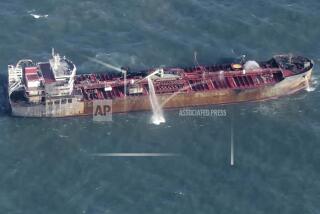Sunken tanker mystery: Where’s the oil?
- Share via
It was just after sunrise on Dec. 23, 1941, when the tanker Montebello was hit by a torpedo from a Japanese submarine just off the Central California coast, taking 3 million gallons of crude oil with it as it sank.
All 38 crewmen aboard the Union Oil Co. of California vessel survived and rowed their way ashore. But since the World War II attack just weeks after Pearl Harbor, the tanker has rested 900 feet below the ocean surface off the coast of Cambria.
In recent years, worries have mounted that if crude began to leak from the 440-foot vessel it could foul the state’s waters and shoreline, creating an environmental catastrophe. Past surveys have shown no evidence of oil.
But now, after nearly two weeks of the most advanced testing yet, a team of researchers has concluded that not only does the vessel pose no risk, the oil is long gone.
State and federal officials announced Thursday they had found virtually no evidence of oil inside the tanker’s cargo and fuel tanks and said the sunken vessel can be scratched off the list of possible threats to the California coast.
“It turned out to be the best possible news,” said Andrew Hughan, a spokesman for the California Department of Fish and Game, whose Office of Spill Prevention and Response took part in the joint operation with the U.S. Coast Guard and the National Oceanic and Atmospheric Administration.
“At the end of the day, the Montebello is filled with seawater,” he said.
The group of scientists and engineers spent 11 days testing the vessel for the presence of oil with a remotely operated underwater vehicle, capturing images and video of its rusted, barnacle-covered surface and measuring the thickness of its hull.
Though the tanker had been surveyed for oil twice before on underwater dives since 1996, with each examination coming up negative, new technology allowed researchers to measure the density of the liquid inside the ship and drill into the fuel tanks for samples to determine what sort of pollution risk the 70-year-old oil posed.
Instead, the inspection showed that the ship’s 32 oil tanks were filled almost entirely with seawater.
The expedition was the result of a task force put together in 2009 by state Sen. Sam Blakeslee (R-San Luis Obispo), who became worried about the potential of an environmental disaster if oil remained in the sunken ship, which rests about six miles off the coastline just south of the federally protected Monterey Bay National Marine Sanctuary.
The amount of oil that was stored in the Montebello is more than six times what was released in the 1990 American Trader oil spill off the coast of Huntington Beach, a disastrous event that killed thousands of birds and marred the ocean for weeks.
One mystery lingers: Where did the 3 million gallons of crude go?
The answer may never be known, but scientists have developed one scenario: Some of the oil leaked out and evaporated within the first few days after the boat went down. The bulk of it probably gurgled to the surface as the ship sank, drifting south and away from the shoreline, scientists suggested.
Whatever was left inside might have washed ashore but, scattered so widely, it probably went unnoticed.
Still, with so much unknown about the conditions at the time, National Oceanic and Atmospheric Administration Scientific Support Coordinator Jordan Stout said, “We will probably never know what happened to the oil.”
Samples taken from the fuel tanks and sediment on the ocean floor were sent to a laboratory for analysis, and a final report is expected early next year.
More to Read
Sign up for Essential California
The most important California stories and recommendations in your inbox every morning.
You may occasionally receive promotional content from the Los Angeles Times.










